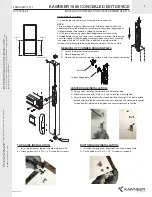
NI USB-9234 User Guide and Specifications
14
ni.com
The NI USB-9234 also has TEDS circuitry. For more information about
TEDS, go to
ni.com/info
and enter
rdteds
.
Understanding NI USB-9234 Filtering
The NI USB-9234 uses a combination of analog and digital filtering
to provide an accurate representation of in-band signals while rejecting
out-of-band signals. The filters discriminate between signals based on the
frequency range, or bandwidth, of the signal. The three important
bandwidths to consider are the passband, the stopband, and the alias-free
bandwidth.
The NI USB-9234 represents signals within the passband as quantified
primarily by passband flatness and phase nonlinearity. The filters reject
frequencies within the stopband as much as possible, as quantified by
stopband rejection. All signals that appear in the alias-free bandwidth are
either unaliased signals or signals that have been filtered by at least the
amount of the stopband rejection.
Passband
The signals within the passband have frequency-dependent gain or
attenuation. The small amount of variation in gain with frequency is called
the passband flatness. The digital filters of the NI USB-9234 adjust the
frequency range of the passband to match the data rate. Therefore, the
amount of gain or attenuation at a given frequency depends on the data rate.
Figure 11 shows typical passband flatness for 51.2 kS/s data rate.
Figure 11.
NI USB-9234 Typical Passband Response
Frequency (kHz)
30
25
20
0.025
0.000
–0.025
–0.050
15
10
5
0
Gain (dB)









































